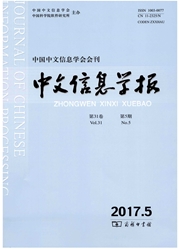

 中文摘要:
中文摘要:
本文首先介绍WordNet、VerbNet、PropBank和FrameNet这几个主流语义资源的结构,并分析其各自的缺陷;然后,介绍怎样在不同的资源之间建立起映射关系(包括义项映射和框架映射),达到语义资源的统一和整合,形成词汇语义资源的连接和互补;最后,介绍面向自动推理的更加深层的语义关系的表示和标注的趋向:从动词的论元结构走向句子的命题结构,不同动词和句子所表达的事件及其关系,不同词类范畴(动词和事件名词等)所表示的相关事件及其关系,指代词、空语类跟有关表示事件的先行语之间的回指关系。
 英文摘要:
英文摘要:
This paper firstly introduces the architecture and defects of the mainstream semantic resources, such as WordNet, VerbNet, PropBank and FrameNet. Then, it demonstrates how to create a mapping relation of word sense and semantic frame between these different semantic resources, so as to realize to the linking, unification and mutual complement of these resources. Finally, it shows the new trend of the deep semantic representation and an- notation which aims to automatic inference: from the argument structure of verb to the propositional structure of sentence, events and event relation between related verbs, sentences, and different parts of speech (e. g., verbs and the nouns denoting event), the anaphoric relation between deictic, pronoun, empty category and their antecedents denoting event.
 同期刊论文项目
同期刊论文项目
 同项目期刊论文
同项目期刊论文
 期刊信息
期刊信息
